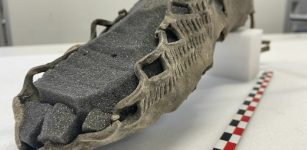World’s Oldest Hand Stencils Were Made By Neanderthals In The Maltravieso Cave 66,000 Years Ago
Jan Bartek - AncientPages.com - Inside the Maltravieso Cave in Spain, researchers have carefully examined several fascinating ancient rock paintings. Dating cave art is typically challenging because mineral-based pigments cannot be analyzed using carbon dating methods. However, scientists have employed the U-series dating technique on calcium carbonate crusts that cover parts of the artwork.
A recent study by researchers from the University of Southampton and partnering institutions reveals that hand stencils in Maltravieso Cave are over 66,000 years old. This finding suggests that Neanderthals, rather than modern humans, were the first artists in history. Hand stencils and prints are among the earliest forms of intentionally created visual art preserved in archaeological records. Although Maltravieso Cave contains more than 60 red hand stencils, their exact ages had remained uncertain until now.
The study titled "The age of hand stencils in Maltravieso cave (Extremadura, Spain) established by U-Th dating, and its implications for the early development of art," published in the Journal of Archaeological Science: Reports, details how researchers applied U-series dating to calcium carbonate crusts overlying these hand stencils within the cave's Sala de las Pinturas and Galería de la Serpiente.
The U-series dating method is recognized as non-destructive because it does not extract material from the artwork itself. Instead, it analyzes small amounts of mineral deposits that form over parts of the artwork, thus preserving its integrity. In a recent study, 22 carbonate samples were examined. The minimum ages for the cave art range from the Holocene to the Middle Paleolithic era. Notably, a crust covering hand stencils in one of the cave's deepest areas dates back to 66,700 years ago, indicating that Neanderthals likely created these illustrations.
Entrance to the Maltravieso Cave. Credit: Mario Modesto - CC BY-SA 3.0
There is also a possibility that some of this art was made by modern humans since certain pigments have been covered by carbonate crusts for only about 6,000 years; however, the actual art could be much older. It's important to note that moisture and carbonate formations are not consistent and can vary in their deposition over time. The oldest three samples analyzed were dated 46,600 years ago, 55,240 years ago, and 66,710 years ago, respectively.
Uranium isotopes decay consistently into thorium, making U-series dating ideal for samples aged several hundred to 500,000 years. In soil, a mixture of uranium and thorium isotopes exists, but their origins can't be identified, so exposed soil remains undatable. Rain dissolves uranium in water while thorium stays behind. Surface water infiltrates caves carrying dissolved minerals like uranium isotopes.
As it evaporates, calcium carbonate crusts form and accumulate as sediments. Within these layers, the conversion of uranium to thorium can be measured independently over millennia. By analyzing the uranium-thorium ratio in these crusts covering ancient cave art, researchers can accurately date them and establish a minimum age for the pigment below.
Handprints and footprints discovered on the Tibetan Plateau have been dated to around 200,000 years ago. These impressions were likely made by children pressing their hands and feet into mud near a hot mineral spring. There is an ongoing discussion among researchers about whether these prints were intentional artistic expressions or simply remnants of human activity.
Panel P III and sample locations for MAL1, MAL22, and MAL23. The left picture shows the original photo, the right is the same picture after application of DStretch (correlation LDS 15 %). Credit: Journal of Archaeological Science: Reports (2024). DOI: 10.1016/j.jasrep.2024.104891
In a related study, researchers at the Cave of La Pasiega in Spain used U-series dating to determine that the well-known red dot art must be older than 64,800 years. This red dot style is prevalent in ancient cave art across Spain, and although much of it remains undated, recent findings suggest that Neanderthals in Spain were actively involved in creating art.
Handprints and footprints discovered on the Tibetan Plateau have been dated to around 200,000 years ago. These impressions were likely made by children pressing their hands and feet into mud near a hot mineral spring. There is an ongoing discussion among researchers about whether these prints were intentional artistic expressions or simply remnants of human activity.
See also: More Archaeology News
In a related study, researchers at the Cave of La Pasiega in Spain used U-series dating to determine that the well-known red dot art must be older than 64,800 years. This red dot style is prevalent in ancient cave art across Spain, and although much of it remains undated, recent findings suggest that Neanderthals in Spain were actively involved in creating art.
The study was published in the Journal of Archaeological Science
Written by Jan Bartek - AncientPages.com Staff Writer























